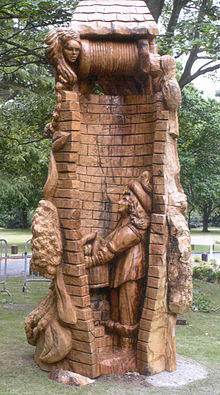
Castanea sativa, the sweet chestnut, Spanish chestnut or just chestnut, is a species of tree in the family Fagaceae, native to Southern Europe and Asia Minor, and widely cultivated throughout the temperate world. A substantial, long-lived deciduous tree, it produces an edible seed, the chestnut, which has been used in cooking since ancient times.

C. sativa attains a height of 20–35 m (66–115 ft) with a trunk often 2 m (7 ft) in diameter. The bark often has a net-shaped (retiform) pattern with deep furrows or fissures running spirally in both directions up the trunk. The trunk is mostly straight with branching starting at low heights. Sweet chestnut trees live to an age of 500 to 600 years. In cultivation they may even grow as old as 1000 years or more. Their large genetic diversity and different cultivars are exploited for uses such as flour, boiling, roasting, drying, sweets or wood. The oblong-lanceolate, boldly toothed leaves are 16–28 cm (6–11 in) long and 5–9 cm (2–4 in) broad.
The tree requires a mild climate and adequate moisture for good growth and a good nut harvest. Its year-growth (but not the rest of the tree) is sensitive to late spring and early autumn frosts, and is intolerant of lime. Under forest conditions, it will tolerate moderate shade well. It can live to more than 2,000 years of age in natural conditions, see the poetically-named “hundred-horse chestnut” in eastern Sicily for example.
This video is specific to the American Chestnut tree
Some more information here: https://www.usda.gov/media/blog/2019/04/29/what-it-takes-bring-back-near-mythical-american-chestnut-trees
***
How to Harvest and Store Chestnuts
Source: https://www.thespruceeats.com/how-to-harvest-and-store-chestnuts-1388176
Harvesting
Chestnuts are typically harvested mid-September through November and are one of the easiest nut varieties to harvest and prepare for storage. Here’s what you do:
- Wait for the chestnuts to fall to the ground.
- Gather up all of the nuts with open burrs. (You’ll definitely want gloves for this job.)
- Remove the nuts from the burrs. Discard any with wormholes or other signs of damage.
- Promptly store the chestnuts in air-tight containers and refrigerate or freeze.
Tips
- Beat the squirrels: Try to gather the chestnuts as soon as they fall to the ground. It will preserve the quality of the nuts and minimize loss to squirrels (they love chestnuts, too).
- Look for open burrs: When the chestnut is mature, the burrs will open, and that’s when you want to remove the husks. Leave the dark brown inner shell.
- Don’t shell until needed: Chestnuts will dry out within a week of being removed from the shell. Keep them fresh by shelling them right before you’re ready to use them.
- Store properly: In-shell chestnuts will keep in the refrigerator for a month or in the freezer for a year.
- Listen for the rattle: Chestnuts that are in the shell dry out and shrink as they age. Test the freshness of chestnuts by shaking them. If you hear rattling inside the shell, they may be too dry to eat.
- Sorting chestnuts: When sorting chestnuts, look for shells that are smooth, glossy and heavy. These will hold the tastiest nuts.
Eating
Chestnuts are delicious and have a mild, semi-sweet flavor. When raw, they are crunchy and will soften when cooked.
There are many ways to enjoy your harvested chestnuts. Roasting chestnuts is a very popular method and a favorite holiday treat. Chestnuts can also be boiled or braised.
Chestnuts are a common ingredient in many recipes. They can be used in desserts, stuffings, soups and savory meat dishes. Candied chestnuts are delicious and a great way to reward yourself after the harvest!
You can even make your own chestnut flour to use in bread.
***

Roasted chestnuts recipe
Source: https://www.bbc.co.uk/food/recipes/roastchestnuts_68084
Ingredients
- 1kg/2¼lb chestnuts
Method
- Heat the oven to 200C/400F/Gas 6.
- Using a small, sharp knife, cut a cross into the skin of each nut. Put in a roasting tin and bake until the skins open and the insides are tender, about 30 minutes.
- Serve in paper bags, if you like. To eat, peel away the tough outer skin and the pithy white inner skin to get to the sweet kernel
***

